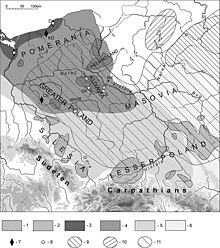Neman culture
Mesolithic, Para-Neolithic | |
| Dates | c. 5100 BC – c. 2000 BC |
|---|---|
| Preceded by | Janisławice culture, Oder Final Mesolithic, Narva culture, Kunda culture, Zedmar culture |
| Followed by | Funnelbeaker culture, Globular Amphora culture, Corded Ware culture, Rzucewo culture, Mierzanowice culture, Trzciniec culture |
The archaeological Neman culture (
Mesolithic
During the
Neolithic

The Neolithic began with the appearance of pottery in mid 5th millennium BC. The Semi-Neolithic Neman culture was a successor of the Mesolithic Neman culture. Most of flint tools are very similar between both cultures. A new widespread development was knives with sharpened and flared point.[8] Pottery of the Neman culture had pointed bottoms and was made of clay mixed with organic matter or crushed quartzite.[8] Some latter examples have flat bottoms. The vessels were a bit narrower and curvier than of the Narva culture. They were decorated with a thin layer of white clay and rows of small imprints around the rim.[9] The rest of the vessel had diagonal stripes forming a pattern of a fishnet or more rows of small imprints.[10] Some pottery found in settlements of the Neman culture was made by Narva culture. Such phenomenon is explained by trade of flint, which Narva culture in the north did not have.[11] Towards the end of the Neman culture, the pottery became more varied and exhibits influence of the Rzucewo culture: imprints made by a cord or resembling a fir.[12] Eventually, the culture was overtaken by the Globular Amphora culture and the Corded Ware culture.
Gallery
Citations
- .
- .
- ^ a b Juodagalvis 2000, p. 24.
- ^ Juodagalvis 2000, p. 26.
- ^ Juodagalvis 2005, p. 72.
- ^ Juodagalvis 2005, p. 74.
- ^ Juodagalvis 2005, pp. 72–73.
- ^ a b Juodagalvis 2000, p. 30.
- ^ Girininkas 2005, p. 144.
- ^ Girininkas 2005, p. 145.
- ^ Girininkas 2005, p. 147.
- ^ Zinkevičius, Luchtanas & Česnys 2007.
Cited sources
- Girininkas, Algirdas (2005). "Neolitas". ISBN 9955-584-90-4.
- Juodagalvis, Vygandas (2000). "Neolithic Period". Prehistoric Lithuania. Archaeology Exhibition Guide. National Museum of Lithuania. ISBN 9955-415-07-X.
- Juodagalvis, Vygandas (2005). "Mezolitas". ISBN 9955-584-90-4.
- Zinkevičius, Zigmas; Luchtanas, Aleksiejus; Česnys, Gintautas (2007). "Papildymai. Nemuno kultūra". Tautos kilmė (in Lithuanian). Mokslo ir enciklopedijų leidybos institutas. Archived from the originalon 2011-07-22.


